CIVIL TECHNOLOGY GRADE 12 MEMORANDUM - NSC PAST PAPERS AND MEMOS SEPTEMBER 2017
Share via Whatsapp Join our WhatsApp Group Join our Telegram GroupCIVIL TECHNOLOGY
GRADE 12
NSC PAST PAPERS AND MEMOS
SEPTEMBER 2017
MEMORANDUM
QUESTION 1: CONSTRUCTION PROCESSES
1.1 FIGURE 1.1 shows the substructure of a structure.
1.1.1 150 mm / 200 mm (1)
1.1.2 150 mm (1)
1.1.3 220 mm (1)
1.1.4 Concrete (1)
1.1.5 Hard core filling (1)
1.1.6 Any TWO purposes of part 1.1.D.
- Solid base for concrete floor
- Give level surface. (2 x 1) (2)
1.2 Any similar answer:
- (1) Water weakens (2) sub-soil / foundations can sink.
- (1) Water can dam up against foundations (2) and spread to walls. (2)
1.3 (1) Makes burning process easy because (2) it burns right through to the centre of the brick. (2)
1.4 Any THREE properties of face bricks.
- Hard
- Strong
- Does not absorb water
- Inner and outer walls (3 x 1) (3)
1.5 Describe in point form the manufacturing process of clay bricks.
- (1) Clay / scale / brick soil are dug out, (2) ground and (3) mixed with water.
- (4) Cast in moulds. (5) Dried. (6) Baked in kilns. (6)
1.6 FIGURE 1.6 shows a wood door frame.
1.6.1 (1) Anchors / Frame ties (2) are built into brick joints. (2)
1.6.2
- 1.1.A – Head
- 1.1.B – Strut
- 1.1.C – Frame stile (3)
1.6.3 813 (1)
1.6.4 Anchor frame to floor. (1)
1.7 Name the tools in FIGURES 1.7.1 to 1.7.3.
1.7.1 Plaster trowel (1) 1.7.2 Belt sander (1)
1.7.3 Line and pins (1)
[30]
QUESTION 2: ADVANCED CONSTRUCTION PROCESSES
2.1
2.1.1 Main bar (1)
2.1.2 Withstand tensile stress / Shear stress over shear line (1)
2.1.3 High tensile steel (1)
2.1.4 16 mm (1)2.1.5 Sturrups (1)
2.1.6 Any TWO purposes of the bars at 2.1.B.
- Withstand shear stress
- Bind main bars (2 x 1) (2)
2.2 Any TWO requirements of the steel for steel reinforcement
- (1) Capable of resisting tensile stress (2) without significant strain
- (1) Easily bent (2) into required shape
- (1) Surface must bond adequately (2) with concrete (Any 2 x 2) (4)
2.3 Similar answer:
- (1) Prevent damp from (2) penetrating to reinforcement / causing rust. (2)
2.4
- Rough arch – Standard bricks
- Gauged arch – Wedge shape bricks (2)
2.5 Similar answer:
- (1) Allow for / glass not break (2) expansion and shrinking of glass. (2)
2.6 Any THREE safety rules when working on floors and stairs with open sides.
- Sufficiently lighting
- Free from material, waste and obstacles
- Sufficiently covered
- Sufficient trap platforms or nets
- Safety equipment must be used (3 x 1) (3)
2.7
2.7.1 – clamp
2.7.2 – bearer
2.7.3 – strut
2.7.4 – prop
2.7.5 – soleplate (5 x 1) (5)
2.8 Open eave construction: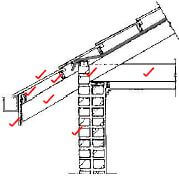
- Outer wall
- Rafter
- Tie beam
- Facia board (gutter board)
- 2 purlins
- Tile roof covering
- Beam filling (8)
2.9 (1) Wall or soil (2) which must be supported. (2)
2.10 Indicate whether the following statements are TRUE or FALSE.
2.10.1 False (1)
2.10.2 False (1)
2.10.3 True (1)
2.10.4 True (1)
2.10.5 False (1)
[40]
QUESTION 3: CIVIL SERVICES
3.1 3.1.1 Septic tank (1)
3.1.2 (1) Digests and liquefy by (2) anaerobic bacteria and other biological life such as maggots / worms / micro-organisms. (2)
3.1.3 Gas escape (1)
3.1.4 (1) Not disturbing (2) surface water layer. (2)
3.1.5 French drain (1)
3.2 (1) Sucking / pressure as result of outlet of drain (2) can push or suck water lock out. (2)
3.3 S-trap (3)
(3)
3.4
3.4.1 STRAIGHT (1)
3.4.2 SLIGHTLY SMALLER (1)
3.4.3 6 mm (1)
3.5 Any THREE methods to generate electricity.
- Hydro
- Wind
- Sun
- Steam – Coal / Nuclear (Any 3 x 1) (3)
3.6 Protect electrical cables (1)
3.7 (1) Lead water to water tank (2) in roof to raise pressure. (3) Water then lead to draw-off points. (3)
3.8 User pipe (1)
3.9
3.9.1 False (1)
3.9.2 True (1)
3.9.3 False (1)
3.9.4 False (1)
3.9.5 False (1)
3.10
3.10.1 Stop cock (1)
3.10.2 Any ONE example where this type of tap must be installed.
- Before geysers
- Cistern
- Storage tanks
- Water service point (Any 1 x 1) (1)
[30]
QUESTION 4: MATERIALS AND QUANTITIES
4.1 (1) Chemical (2) Physical / bind / harden (2 x 1) (2)
4.2 (1) Damp in air (2) react with cement particles (2)
4.3 Any ONE purpose of lime in a mortar mix.
- Better workability
- Better plasticity property for mortar
- When sand has insufficient round particles
- When not sufficient fine sand particles
- Better water retaining capacity (Any 1 x 1) (1)
4.4 Stone (1)
4.5 Any THREE methods of curing of concrete.
- Retaining formwork
- Covers
- Ponding
- Spraying
- Curing compounds (Any 3 x 1) (3)
4.6 Similar answer:
- (1) To test compressive stress to (2) ensure that concrete comply to requirements. (2)
4.7 Name TWO uses of each of the following materials:
4.7.1 Copper:
- Electrical wires
- Electrical equipment
- Water pipes
- Heads of soldering irons (Any 2 x 1) (2)
4.7.2 Zink:
- Alloy material
- Covering of iron and roof sheets (2 x 1) (2)
4.8 Channel iron. ![]() (2)
(2)
4.9 Any THREE properties of a good preservative for wood.
- Easily absorbed
- Cheap
- Readily available
- Not poisonous / harmful to humans and animals
- Not easily macerate
- Not corrode metal
- Not reduce strength of wood
- Not unpleasant smell
- Not spoil natural beauty of wood
- Not resist paint, varnish, glue, etc.
- Not flammable (Any 3 x 1) (3)
4.10 (1) Odd number layers (2) veneer glued upon the other. (2)
4.11 Use the quantity list on ANSWER SHEET A and determine the volume concrete which will be needed for a floor with a length of 6 m, width of 3 m and thickness of 75 mm. (3)
4.12 Use the quantity list on ANSWER SHEET A and determine the number of bricks which will be needed for a cavity wall with a length of 4 m and a height of 2,4 m. (5)
[30]
QUESTION 5: APPLIED MECHANICS
5.1 FIGURE 5.1 on ANSWER SHEET B show the space diagram of a lean to roof. Determine graphically scale 1 mm = 1 N on ANSWER SHEET B the size and nature of the forces in the parts of the truss by drawing the force diagram and completing the table. 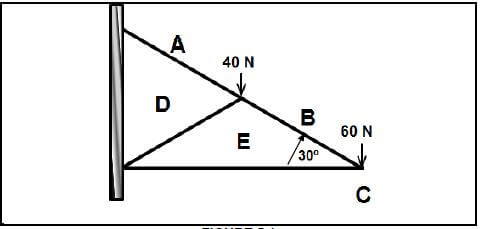 (14)
(14)
5.2 FIGURE 5.2 on ANSWER SHEET C show a beam with point loads. Calculate on ANSWER SHEET C the following: 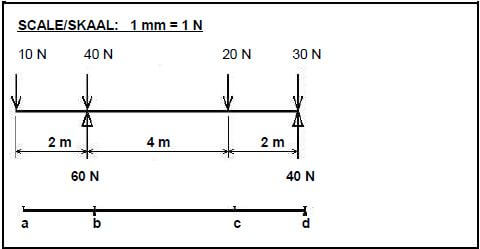
FIGURE 5.2
5.2.1 The bending moment values (6)
5.2.2 Complete the bending moment diagram on scale 1 mm = 1 N according to the bending moment values (4)
5.3 Determine the sentroid of the body in FIGURE 5.3 from point P. (The table on ANSWER SHEET C can be used for the calculations.) 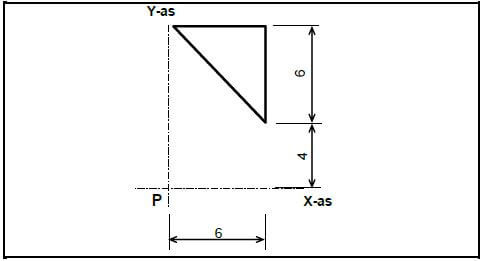
FIGURE 5.3 (6)
[30]
QUESTION 6: GRAPHICS AND COMMUNICATION
6.1 Any FOUR responsibilities of the architect in the design of a structure.
- Determine the needs of the owners
- Determine the arrangement of rooms
- Determine arrangement of windows and doors
- Show dimensions
- Show outside views
- Show roof appearance (4 x 1) (4)
6.2
6.2.1 Water closet (2)
6.2.2 Sink ![]() (2)
(2)
6.2.3 Water meter ![]() (2)
(2)
6.3 Site plan (1)
6.4 FIGURE 6.4 on ANSWER SHEET D shows the floor plan of a store room on scale 1 : 50. Draw the south elevation on scale 1 : 50 on ANSWER SHEET D from the given ground level line by using the following information:
- The floor level above the ground level: 200 mm
- Wall height from the floor level to the ceiling: 2 600 mm
- Window 1 : 600 x 2 100 mm
- Door 1 : 1 400 x 2 100 mm
- Door knob
- Roof construction pitch: 30º
- Indicate construction line to determine the roof height
- Gabel end at west elevation
- Hipped roof at east elevation
Use the mark table on ANSWER SHEET D as reference.
(29)
[40]
TOTAL: 200
ANSWER SHEET | CIVIL TECHNOLOGY | NAME: |
4.11 Use the quantity list on ANSWER SHEET A and determine the volume concrete which will be needed for a floor with a length of 6 m, width of 3 m and thickness of 75 mm. (3)
4.12 Use the quantity list on ANSWER SHEET A and determine the number of bricks which will be needed for a cavity wall with a length of 4 m and a height of 2,4 m. (5)
A | B | C | D |
4.11 | |||
1/ | 6 | ||
3 | |||
0,75 | 13,5 | Thus: 13,5 m2 concrete needed for the floor | |
4.11 | |||
1/ | 4 | ||
2,4 | 9,6 | Wall area = 9,6 m2 | |
9,6 | |||
100 | 960 | Thus: 960 bricks needed for the wall | |
ANSWER SHEET | CIVIL TECHNOLOGY | NAME: |
QUESTION 5.1 (14)
SPACE DIAGRAM: 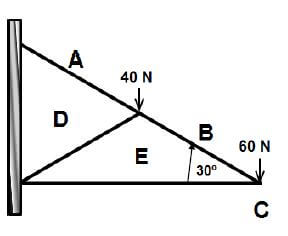
FORCE DIAGRAM
SCALE: 1 mm = 1 N
|
| Nature | |
PART | Size | | |
AD | 160 N | ||
BE | 120 N | | |
CE | 104 N | ||
DE | 40 N | ||
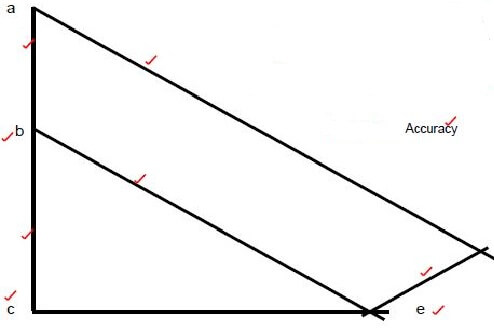
ANSWER SHEET | CIVIL TECHNOLOGY | NAME: |
QUESTION. 5.2
5.2.1 The bending moment values (4)
- a = 0 N.
b = (-10 N x 2) = -20 N
c = (-10 N x 6) + (-40 N x 4) + (60 N x 4) = 20 N
d = (-10 N x 8)+(-40 N x 6) + (60 N x 60) + (-20 x 2) = 0 N
5.2.2 The bending moment diagram (4)
SCALE: 1 mm = 1 N 
FIGURE 5.2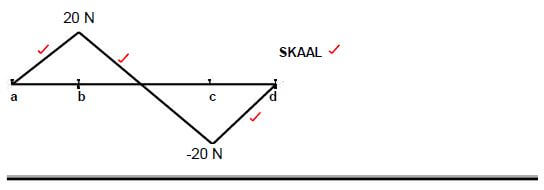
QUESTION 5.3 (6)
Shape | X | Y |
 | h 6 | h 6 |
ANSWER SHEET | CIVIL TECHNOLOGY | NAME: |
QUESTION 6.4 (26) 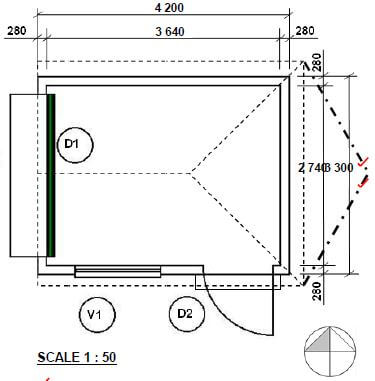
SCALE 1 : 50 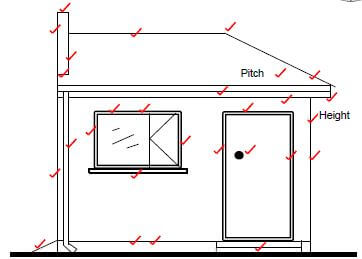
Floor level | 2 | |
Wall | 3 | |
Window | 3 | |
Window sill | 1 | |
Door | 4 | |
Step | 1 | |
Ramp | 1 | |
Facia board | 2 | |
Gutter | 1 | |
Down pipe | 1 | |
Gable end | 4 | |
Hipped roof | 3 | |
Roof height | 3 | |
TOTAL | 29 |